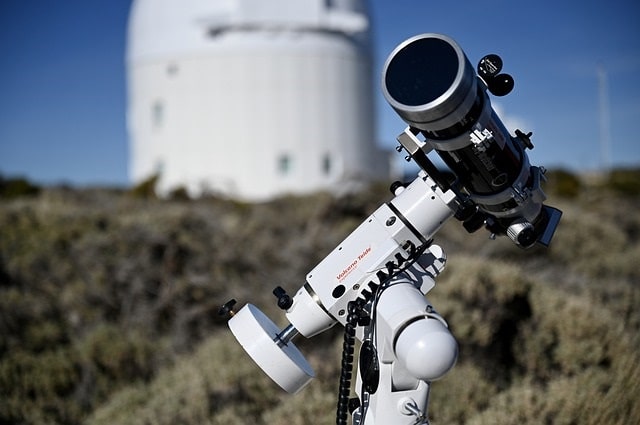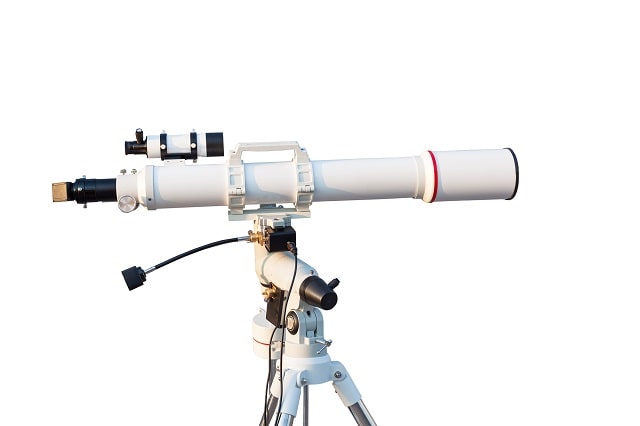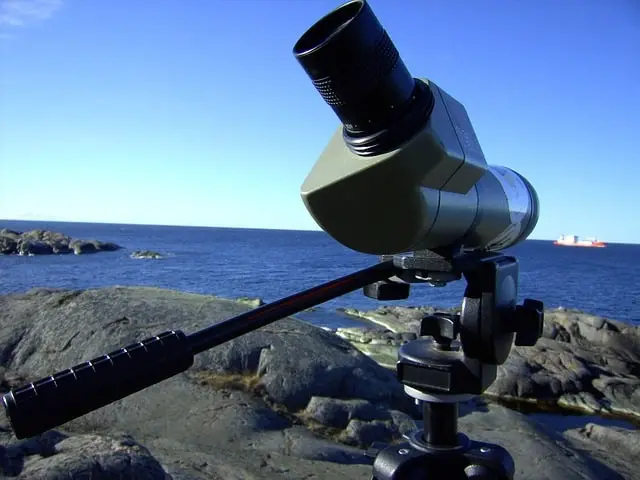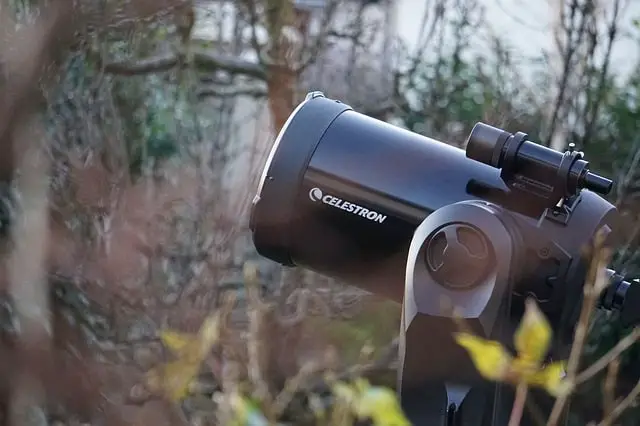Realistically, you should budget between $75 and $250 for your first telescope. Continue reading for more on how much a good telescope should cost…
If you’re in the market for a good scope, you’re probably wondering about the cost. You may be worried that astronomical equipment is expensive and that a decent scope could be out of your price range. Fortunately, the answer to the question “how much does a good telescope cost?” may be more affordable than you think.
This guide covers everything you need to know about the cost of a good telescope, the best telescope manufacturers, and what type of telescope offers the best value for the money.
You’ll learn:
- What’s the Price Range for a Good Telescope?
- What are the Best Telescope Manufacturers?
- What is Aperture and What are the Different Types of Telescope?
- Which Type of Telescope is the Best Value for Money?
- Additional Reading on Telescopes
What’s the Price Range For a Good Telescope?

Despite what you might have heard, you can get a good scope at almost any price. Sure, telescopes (and other astronomical equipment) can set you back thousands of dollars, but you can easily buy a decent beginner’s scope relatively inexpensively. (For more, check out our guide to buying your first scope here!)
Realistically, if you have little to no astronomical experience, you should budget between $75 and $250 for your first telescope.
If you’ve been interested in astronomy for some time and have some experience with both naked eye and binocular astronomy, then your upper limit is more likely dependent upon how much you can afford to spend.12
Why? Buying a telescope isn’t just an investment of money, it’s also an investment of time and devotion to the hobby. If you’re new to the hobby, it’s easy (and common) to want to jump right in and buy the best telescope you can afford. However, unless you know what to look for and have realistic expectations of what you can see, the chances are your interest could wane as quickly as the Moon wanes from full to new.3
Before you know it, the scope you spent hundreds of dollars on – as fine as it is – is now gathering dust in the garage or the attic.
With this in mind, if this is your first scope and you have little or no experience with the hobby, it’s best to spend no more than about $250 on your first scope. That way, if you lose interest, then you haven’t lost too much money either. Conversely, if your interest grows and you find yourself wanting to upgrade, you’ll look upon that initial outlay as an investment that’s paid dividends.
If, on the other hand, you’ve already invested the time in getting to know the stars and have realistic expectations, you’re far less likely to lose interest and are most likely ready to spend whatever amount you feel you can afford.
What Are the Best Telescope Manufacturers?

Many amateur astronomers will tell you the three most reputable manufacturers of astronomical equipment are Celestron, Meade, and Orion. Other reputable manufacturers include Zhumell and Sky-Watcher, and it’s advisable to stick with those name brands.
Everyone has their own favorite brand, just as everyone has a preference for cars and airlines, but everyone agrees that you shouldn’t buy a “department store scope.”
These are the scopes you’ll find in chain stores and outlets that boast magnifications of 500x or 1000x, which for a scope that size and price, is extremely unrealistic and misleading. While these might still be useful and inspiring to a child, they’re little more than toys and aren’t really capable of performing well.
As such, if you’re looking for a quality first telescope, capable of opening up the wonders of the universe, you should avoid these as you’ll be left feeling disillusioned and disappointed.
What is Aperture and What Are the Different Types of Telescope?

Put simply, the aperture of a scope is the diameter of its lens or its mirror.4 It’s typically specified in millimeters, but you might also see it listed in inches too. The larger the aperture, the more light it can gather. The more light it can gather, the fainter the object it can see and the more detail will be visible.
It’s no surprise then that larger apertures cost more money, but that’s not to say you can’t get a good-sized scope for under $250. However, the type of scope you buy may limit the aperture size that’s available to you.
Types of Telescopes: Refractors and Reflectors
There are basically two types of telescope: refractors and reflectors.5 A refractor is what many people imagine when they think of a telescope. It’s basically a long optical tube with a lens at the large end and an eyepiece at the other. The light enters the telescope through the lens and exits through the eyepiece, which is situated at the bottom.
While this is simple enough in principle, refractors have a potentially impractical drawback: the larger the lens (its aperture), the longer the optical tube that’s required. Without going into technical detail, this is because a longer tube is needed to bring the light to a single focal point. That being the case, most commercial refractors have a lens/aperture of less than 130mm in diameter.
A reflector telescope is able to solve this problem by using mirrors to bounce the light inside the tube. Instead of light entering through a lens, it enters through the open end of the optical tube and is reflected off the primary mirror at the bottom. The light then travels back up the tube toward the open end but is reflected again by a smaller, secondary mirror.
This secondary mirror is angled so that the light is bounced out of the tube through the eyepiece, which is located on the side of the optical tube, rather than at the end. This allows for a shorter optical tube, making it possible to have larger aperture scopes without compromising on portability or image quality.
That said, the mirrors in a reflector telescope tend to need minor re-alignment (called collimation) from time to time, whereas refractors are sturdier and need less maintenance.
Catadioptric Telescopes
A third type of telescope is also very popular among amateur astronomers. A compound or catadioptric telescope is a hybrid of the refractor and reflector scopes and utilizes both lenses and mirrors in its design.6 Light enters the optical tube through a lens (like a refractor) and is then bounced off the primary mirror at the bottom (like a reflector).
The light then travels back up the tube to a smaller, secondary mirror (also like a reflector), but rather than exiting the tube at an angle, the reflected light travels back down the tube and exits through the eyepiece at the bottom of the tube (like a refractor.)
The design of the scope produces a better quality image while retaining a short optical tube that allows for a larger aperture and, consequently, greater portability.
Which Type of Telescope is the Best Value for Money?

The simple answer here is that you can buy the same aperture refractor, reflector or compound scope for about the same price. For example, searching for “90mm telescope” on Amazon.com will produce results for different telescope types from our top name brands for roughly $200.
As you browse, you may notice a few exceptions to the general rule. In particular, you may see computerized scopes that can cost several hundred dollars more than a regular, manual scope of the same size.
Computerized vs Manual Telescopes
A computerized (or “GoTo”) scope has a built-in database of thousands of celestial objects.7
After setting your location, date, and time and aligning the scope with a few bright stars, you only need to select an object and the scope will “go to” your target of choice.
Computerized scopes can save you a lot of time when you’re observing, but there are many amateur astronomers who prefer to track down and discover an object for themselves. The fun is in the chase, as much as the observation of the object itself.
The other issue with a computerized scope is that you really need to know what you’re looking for. The database typically doesn’t highlight the finest objects you can see from your location and you’ll need to know how to identify your target.
This is because the scope won’t usually place your target directly in the center of your field of view, and you may need to move the scope manually in order to find it. If you don’t know what you’re looking for, or what to expect, the chances are you might miss it when you see it!
It’s also worth remembering that reflectors can present better value for money as mirrors cost less to produce than lenses. With that in mind, if you were to look at the cost per millimeter of aperture, you’ll find that reflectors offer the best value.
This is especially true when you consider that your options for a refractor will, most likely, be limited to apertures of 130mm or less, with the vast majority of available options having apertures of under 100mm.
For example, Celestron offers 114mm reflectors (non-computerized) for as little as $1.32 per millimeter of aperture, while their smaller 102mm refractors start at $2.94 per millimeter of aperture.
All things considered then, it’s not hard to see why many amateur astronomers will choose a reflector over a refractor. Larger apertures offer more bang for your buck; if your budget is $250, the largest refractor Celestron has to offer is 80mm, but you could treat yourself to a 127mm reflector without breaking the bank.
Realistically, any one of the scopes offered by any of the name brands is a fine choice for your first scope. Whether your budget is below $100 or over $250, you can be sure your scope will be more than up to the challenge of helping you to explore the night sky.
Additional Reading on Telescopes
Additionally, if you’re looking for more resources on stargazing, we have a number of articles that you might find interesting.
First off, we’ve created guides on a variety of astronomy related topics, such as our guide to determining how much a telescope should cost (which you’re reading now), our guide to how to use a telescope, our beginner’s guide to astronomy, and our guide on how to buy your first telescope. We’ve also created a series of helpful guides for kids, such as our list of astronomy facts (which any kids or beginners will no doubt find interesting), and our breakdown of astronomy for kids.
We’ve also created a series of buying guides, including our guide to find the best astronomy tools for you, our guide to evaluating the best telescopes for beginners, and our guide to the best astronomy binoculars.
In addition to those guides, we’ve also created a series of in-depth reviews of a variety of telescopes and astronomy binoculars. You can check them out before you buy to find out the best accessories, pros and cons for different models, and even to see what they look like unboxed. If you’re considering buying a telescope we have a series of reviews that also serve as how to guides. You can get our series of guides to individual telescopes as well, including our review of the following telescopes and binoculars: our Celestron Firstscope review, Celestron Travel Scope 80 Telescope Review, SkyGenius 10×50 Binoculars review, Celestron Travel Scope 80 Telescope review, Opticron Adventurer II 10×50 Binocular review, Orion Astronomy 15×70 Binoculars review, Orion XT6 Dobsonian Telescope review, Orion Scenix 7×50 Binocular review, Celestron ExploraScope 114AZ Telescope review, Zhumell Z100 Telescope review, and our Sky-Watcher Heritage 130 Telescope reviews, to really be able to dive into the different telescope and astronomy binocular models.
Article Sources
Moon and Back uses only high-quality sources, including peer-reviewed studies, to support the facts within our articles. Read our editorial process to learn more about how we fact-check and keep our content accurate, reliable, and trustworthy.
- King B. The Eyes Have It – Deep Sky Observing Without Equipment. Skyandtelescope.org. Published June 27, 2018. Accessed March 24, 2021.
- Shickley J. Stargazing with binoculars: a beginner’s guide. Skyatnightmagazine.com. Published August 24, 2018. Accessed March 24, 2021.
- Night Sky Network. Night Sky Planner. Nasa.gov. Accessed March 24, 2021.
- Ventrudo B. The Five Numbers That Explain a Telescope. Cosmicpursuits.com. Published April 4, 2020. Accessed March 24, 2021.
- Danek P. Refractor vs Reflector Telescope – What Is The Difference? Telescopeguides.com. Accessed March 24, 2021.
- High Point Scientific. What is a Catadioptric Telescope? Accessed March 24, 2021.
- Telescope School. Are Computerized GoTo Telescopes Worth the Price? Telescopeschool.com. Accessed March 24, 2021.

